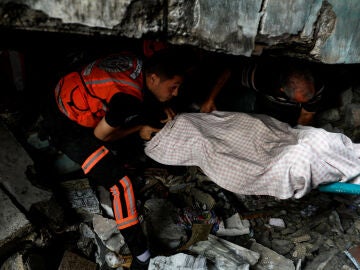
Horror and tension take over, once again, the Gaza Strip. Early this Friday morning, Israel gave 24 hours for Gazans in the center and north of the Strip to flee to the south in the context of an imminent ground incursion by Netanyahu’s Army. Now, with the deadline met, Israel avoids revealing when it will enter the areaalthough it claims to guarantee “safe” routes until 4:00 p.m. (3:00 p.m. peninsular time) to reach the south of the Strip.
The situation is dramatic. Inside the Strip, barely 300 square kilometers, More than a million people live under the Israeli siege for more than a week. International organizations warn: without access to food, water, electricity or fuel, time is running out in the Gaza Strip, where, in addition, bombings are incessant.
From Unicef they remember that almost half of the area’s population are children and accuse Israel of violating humanitarian law. “We need immediate humanitarian access throughout Gaza, so that we can bring fuel, food and water to all those in need. Even wars have rules,” the United Nations insisted this Friday.
Overnight, The Israeli Army has once again launched missiles against the Strip. According to Netanyahu’s forces, the bombs managed to hit a post with dozens of militiamen from Hamas’s elite corps and the operations headquarters for its aerial activity, ending the life of its top commander, Merad Abu Merad, considered one of those responsible. of directing last Saturday’s infiltration.
Since the ‘ultimatum’ to Gaza, the Israeli Army has carried out some specific and rapid incursions, according to the Iranian Government, with the aim of recovering bodies of Israeli hostages from Hamas and carry out tests to find some of the around 130 hostages that the Islamist movement took in its massive attack on October 7.
Following the Israeli warning to Gazans, The movements have been continuous, although there are those who have chosen to remain in their homes or those, on the other hand, have not had the option to choose. The UN recalled, for example, the situation of the thousands of wounded hospitalized: “Transferring more than a million people through a densely populated war zone to a place without food, water or shelter, when the entire territory is under siege, it is extremely dangerous, and in some cases it is simply not possible.
Mahmoud Abbas, president of Hamas’s rival Palestinian Authority, said in a meeting with Antony Blinken in Jordan that the forced displacement of thousands of Palestinians is a reflection of 1948, when hundreds of thousands of Palestinians had to flee or were expelled. of what is today Israel. In fact, the majority of Gazans are descendants of those refugees.
Source: Lasexta
Ricardo is a renowned author and journalist, known for his exceptional writing on top-news stories. He currently works as a writer at the 247 News Agency, where he is known for his ability to deliver breaking news and insightful analysis on the most pressing issues of the day.











